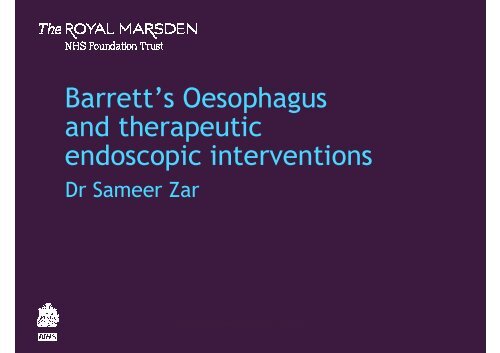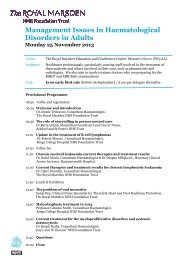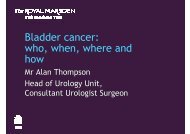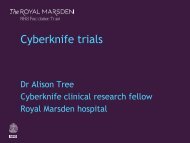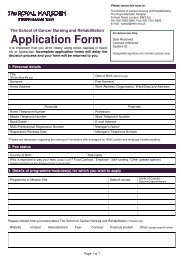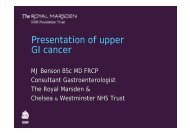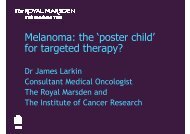Sameer Zar - The Royal Marsden
Sameer Zar - The Royal Marsden
Sameer Zar - The Royal Marsden
Create successful ePaper yourself
Turn your PDF publications into a flip-book with our unique Google optimized e-Paper software.
<strong>The</strong> <strong>Royal</strong> <strong>Marsden</strong><br />
Barrett’s Oesophagus<br />
and therapeutic<br />
endoscopic interventions<br />
Dr <strong>Sameer</strong> <strong>Zar</strong><br />
Change Presentation title and date in Footer dd.mm.yyyy 1
2<br />
<strong>The</strong> <strong>Royal</strong> <strong>Marsden</strong><br />
Barrett’s Oesophagus<br />
Barrett's oesophagus is a condition in which stratified<br />
squamous epithelium in the distal oesophagus is<br />
replaced by metaplastic columnar epithelium to a<br />
varying extent<br />
<strong>The</strong> condition develops as a consequence of chronic<br />
gastroesophageal reflux disease (GORD)<br />
It predisposes to the development of adenocarcinoma of<br />
the oesophagus
3<br />
<strong>The</strong> <strong>Royal</strong> <strong>Marsden</strong><br />
Diagnosis of Barrett’s Oesophagus<br />
Diagnosis of Barrett’s oesophagus is based on<br />
two criteria<br />
– Endoscopic examination<br />
Location of squamocolumnar junction in relationship<br />
to the gastroesophageal junction<br />
– Histological confirmation<br />
Replacement of stratified squamous epithelium with<br />
intestinal metaplasia (columnar lined epithelium)
4<br />
<strong>The</strong> <strong>Royal</strong> <strong>Marsden</strong><br />
Barrett’s Oesophagus - Diagnosis
5<br />
<strong>The</strong> <strong>Royal</strong> <strong>Marsden</strong><br />
Clinical Features of Barrett’s Oesophagus<br />
No specific symptoms<br />
Symptoms related to reflux disease<br />
– Heartburn<br />
– Acid regurgitation<br />
– Retrosternal discomfort/pain<br />
– Dysphagia<br />
– Water brash<br />
– Odynophagia
6<br />
<strong>The</strong> <strong>Royal</strong> <strong>Marsden</strong> Change Presentation title and date in Footer dd.mm.yyyy<br />
Risk factors for Barrett’s<br />
Oesophagus
7<br />
<strong>The</strong> <strong>Royal</strong> <strong>Marsden</strong><br />
Risk Factors Associated with Oesophageal<br />
Adenocarcinoma in Barrett’s Oesophagus<br />
Which of the following is not a risk factor for Barrett’s<br />
Oesophagus:<br />
1. Age 50 years or older<br />
2. Male sex<br />
3. White race<br />
4. Chronic GORD (>10yrs)<br />
5. Hiatus hernia<br />
6. H pylori infection<br />
Screening for Barrett’s should be considered in patients with<br />
multiple risk factors
8<br />
<strong>The</strong> <strong>Royal</strong> <strong>Marsden</strong> Change Presentation title and date in Footer dd.mm.yyyy<br />
Barrett’s Oesophagus<br />
– Caucasian male disease<br />
– 40–100 x increased risk of oesophageal cancer<br />
– Annual progression rate 0.5%/year<br />
– Average age at diagnosis=55<br />
(Shaheen, Am J Gastro 2000)<br />
(Spechler, NEJM 1986)
9<br />
<strong>The</strong> <strong>Royal</strong> <strong>Marsden</strong> Change Presentation title and date in Footer dd.mm.yyyy<br />
Cancer Risk in Barrett’s<br />
Oesophagus – Case for<br />
Screening and Surveillance
<strong>The</strong> <strong>Royal</strong> <strong>Marsden</strong> Change Presentation title and date in Footer dd.mm.yyyy<br />
GORD - Metaplasia - Dysplasia - Carcinoma Model
<strong>The</strong> <strong>Royal</strong> <strong>Marsden</strong> Change Presentation title and date in Footer dd.mm.yyyy<br />
Reflux is a Risk Factor for Adenocarcinoma<br />
of the Oesophagus<br />
Lagergren J et al, New Engl J Med 1999; 340: 825-31
12<br />
<strong>The</strong> <strong>Royal</strong> <strong>Marsden</strong> Change Presentation title and date in Footer dd.mm.yyyy<br />
Incidence of Oesophageal Adenocarcinoma<br />
is on the rise in White Men<br />
Rate per 100,000<br />
4.5<br />
4<br />
3.5<br />
3<br />
2.5<br />
2<br />
1.5<br />
1<br />
0.5<br />
0<br />
1974 1978 1982 1986 1990 1994 1998
<strong>The</strong> <strong>Royal</strong> <strong>Marsden</strong> Change Presentation title and date in Footer dd.mm.yyyy<br />
Oesophageal Cancer is a Lethal<br />
Disease<br />
Shaheen NJ et al. Am J Gastroenterol 2006; 101: 2128-38
14<br />
<strong>The</strong> <strong>Royal</strong> <strong>Marsden</strong><br />
Cancer Risk in Barrett’s Oesophagus<br />
– Observational studies show that endoscopic<br />
surveillance can detect curable dysplasia in Barrett's<br />
– Asymptomatic cancers discovered during surveillance<br />
are less advanced than those found in patients who<br />
present with cancer symptoms
<strong>The</strong> <strong>Royal</strong> <strong>Marsden</strong> Change Presentation title and date in Footer dd.mm.yyyy<br />
Surveillance Detects Cancer at Early Stage<br />
Barrett’s Barrett s Surveillance Surveillance associated associated with with better better cancer cancer stage and<br />
survival survival (Corley, (Corley, Gastro Gastro 2002)<br />
2002)
<strong>The</strong> <strong>Royal</strong> <strong>Marsden</strong><br />
Oesophageal Adenocarcinoma<br />
Incidence rising rapidly<br />
6 Fold increase in last 3 decades<br />
Least studied and deadliest cancer worldwide<br />
5 year survival 10%<br />
Small number of cases<br />
Compare to Colorectal Cancer<br />
Population screening not feasible<br />
So Who should be targeted for surveillance?
17<br />
<strong>The</strong> <strong>Royal</strong> <strong>Marsden</strong><br />
Surveillance of Barrett’s Oesophagus<br />
Barrett’s is a precursor lesion for Adenocarcinoma<br />
Progressive changes in Barrett’s segment offers a<br />
potential opportunity to intervene at an earlier stage<br />
to prevent progression to cancer<br />
Early detection of cancer improves survival
18<br />
<strong>The</strong> <strong>Royal</strong> <strong>Marsden</strong><br />
Risk Factors Associated with Oesophageal<br />
Adenocarcinoma in Barrett’s Oesophagus<br />
Which of the following is not a risk factor for<br />
adenocarcinoma in Barrett’s Oesophagus:<br />
1. Family h/o Oesophageal cancer<br />
2. Family h/o Gastric cancer<br />
3. Alcohol<br />
4. Smoking<br />
5. Increased Body Mass Index<br />
6. Intra-abdominal distribution of body fat
19<br />
<strong>The</strong> <strong>Royal</strong> <strong>Marsden</strong><br />
Risk Factors Associated with Oesophageal<br />
Adenocarcinoma in Barrett’s Oesophagus<br />
Which of the following is not a risk factor for Barrett’s<br />
Oesophagus:<br />
1. Length of Barrett’s segment (>8cm)<br />
2. Severity of reflux symptoms<br />
3. Frequency of reflux symptoms (>3 times/week)<br />
4. Ulceration or stricture in Barrett’s segment<br />
5. NSAIDs, Aspirin and COX -2 inhibitors<br />
6. Duodeno-gastro-oesophageal (Biliary) reflux
20<br />
<strong>The</strong> <strong>Royal</strong> <strong>Marsden</strong><br />
Strategies to Manage Cancer Risk in<br />
Barrett’s Oesophagus<br />
Screening<br />
– General population<br />
– GORD patients<br />
Surveillance<br />
– Barrett’s oesophagus<br />
– Barrett’s oesophagus with risk factors
21<br />
<strong>The</strong> <strong>Royal</strong> <strong>Marsden</strong><br />
Screening For Barrett’s Oesophagus<br />
General population<br />
– 1.6% of general population has Barrett’s<br />
Ronkainen J, Gastroenterology 2005; 129:1825.<br />
– 44 percent of patients lack "troublesome heartburn<br />
and/or acid regurgitation during the past three months<br />
GORD patient<br />
– 14% of adult population has weekly reflux symptoms<br />
(40% have monthly symptoms)<br />
– In patients with GORD symptoms, long-segment<br />
Barrett's oesophagus is found in 3 - 5 % and shortsegment<br />
Barrett's in 10 - 15 %<br />
Winters C Jr,. Gastroenterology 1987; 92:118.<br />
Spechler SJ. N Engl J Med 2002; 346:836.
<strong>The</strong> <strong>Royal</strong> <strong>Marsden</strong><br />
Screening and Surveillance in Barrett’s<br />
Oesophagus<br />
Medical Society Recommendations for Screening and<br />
Surveillance<br />
Endorsement: BSG, ACG, ASGE<br />
No endorsement: AGA<br />
No Quality Trial Data of Natural History and<br />
Screening/Surveillance<br />
Observational data<br />
Computer simulation models
23<br />
<strong>The</strong> <strong>Royal</strong> <strong>Marsden</strong> Change Presentation title and date in Footer dd.mm.yyyy<br />
Screening and Surveillance for Oesophageal<br />
Adenocarcinoma<br />
How many patients with early oesophageal<br />
adenocarcinoma can be potentially indentified<br />
through screening and surveillance?<br />
1 90-100%<br />
2 75%<br />
3 50%<br />
4 20-25%<br />
5 10%
<strong>The</strong> <strong>Royal</strong> <strong>Marsden</strong><br />
Screening for Barrett’s Oesophagus<br />
>40% of patients diagnosed with oesophageal adeno-<br />
carcinoma have no history of heartburn<br />
Majority (>90%) Barrett’s pts will NOT develop<br />
adenocarcinoma<br />
Chak, Cancer 2006<br />
Barrett’s diagnosis negatively impacts Quality of Life<br />
Gerson, GI Endo 2007; Hur, Health Rel QoL 2007
25<br />
<strong>The</strong> <strong>Royal</strong> <strong>Marsden</strong><br />
Screening and Surveillance for Oesophageal<br />
Adenocarcinoma
<strong>The</strong> <strong>Royal</strong> <strong>Marsden</strong><br />
How to Improve Screening for Barrett’s<br />
Oesophagus<br />
>40% of patients diagnosed with oesophageal adeno-<br />
carcinoma have no history of heartburn<br />
Majority (>90%) Barrett’s pts will NOT develop<br />
adenocarcinoma<br />
Chak, Cancer 2006<br />
Barrett’s diagnosis negatively impacts Quality of Life<br />
Gerson, GI Endo 2007; Hur, Health Rel QoL 2007
How to Improve Screening for Barrett’s<br />
Oesophagus<br />
– Review guidelines for<br />
screening<br />
– Identify risk factors for Barrett’s<br />
– Heartburn / 4 weeks / most of the<br />
time – triggers endoscopy<br />
– Improve screening methods<br />
– Videocapsule<br />
– Cytosponge<br />
– Prescribing practices<br />
– Repeat prescriptions for PPI<br />
– Educating public, pharmacists
28<br />
<strong>The</strong> <strong>Royal</strong> <strong>Marsden</strong> Change Presentation title and date in Footer dd.mm.yyyy<br />
How do Patients with Barrett’s Perceive<br />
their Cancer Risk?
29<br />
<strong>The</strong> <strong>Royal</strong> <strong>Marsden</strong> Change Presentation title and date in Footer dd.mm.yyyy<br />
Management of Barrett’s<br />
Oesophagus
<strong>The</strong> <strong>Royal</strong> <strong>Marsden</strong> Change Presentation title and date in Footer dd.mm.yyyy<br />
<strong>The</strong> current screening & surveillance<br />
practice for Oesophageal Adenocarcinoma?
31<br />
<strong>The</strong> <strong>Royal</strong> <strong>Marsden</strong><br />
Managing Cancer Risk in Barrett’s Oesophagus<br />
<strong>The</strong> management of patients with Barrett's<br />
oesophagus involves three major<br />
components:<br />
– Treatment of the associated GORD<br />
– Endoscopic surveillance to detect dysplasia<br />
– Treatment of dysplasia
32<br />
<strong>The</strong> <strong>Royal</strong> <strong>Marsden</strong><br />
How to Screen for Dysplasia in Barrett’s<br />
Oesophagus<br />
Endoscopic evaluation using white light<br />
endoscopy<br />
– Four-quadrant biopsy specimens be taken every 2 cm<br />
– Specific biopsy specimens of any mucosal<br />
irregularities<br />
– Four-quadrant biopsy specimens be obtained every 1<br />
cm in patients with known or suspected dysplasia
33<br />
<strong>The</strong> <strong>Royal</strong> <strong>Marsden</strong> Change Presentation title and date in Footer dd.mm.yyyy<br />
Management of Barrett’s Oesophagus<br />
Management of patients with Barrett’s can be<br />
divided in three categories<br />
– Barrett’s oesophagus without dysplasia<br />
– Barrett’s oesophagus with Low Grade Dysplasia<br />
– Barrett’s with High Grade Dysplasia
34<br />
<strong>The</strong> <strong>Royal</strong> <strong>Marsden</strong> Change Presentation title and date in Footer dd.mm.yyyy<br />
Cancer Risk in Barrett’s Oesophagus<br />
Barrett’s oesophagus<br />
– Risk of cancer 0.3 - 0.5% per year<br />
Shaheen. Gastroenterology 2000:119:333<br />
Barrett’s oesophagus with Low Grade Dysplasia<br />
– Probably 0.6 - 5%<br />
Barrett’s with High Grade Dysplasia<br />
– Risk of cancer 5-8% per year<br />
Spechler: Am J Gastroenterol 2005;100:927<br />
– 12% harbour invasive carcinoma at diagnosis<br />
– Lymph node metastases is
35<br />
<strong>The</strong> <strong>Royal</strong> <strong>Marsden</strong><br />
Cancer Risk in Barrett’s Oesophagus<br />
Endoscopic surveillance is suggested for patients with<br />
Barrett's oesophagus using the following surveillance<br />
intervals:<br />
– No dysplasia: 2 to 5 years<br />
– Low-grade dysplasia: 6 to 12 months<br />
– High-grade dysplasia in the absence of eradication<br />
therapy: 3 months
36<br />
<strong>The</strong> <strong>Royal</strong> <strong>Marsden</strong><br />
Management of Barrett’s Oesophagus<br />
without Dysplasia<br />
Management of patients with Barrett’s who do<br />
not have dysplasia involves:<br />
– Treatment of reflux disease<br />
– PPI (H2 antagonists are inadequate)<br />
– Antireflux surgery<br />
– Surveillance endoscopy for dysplasia every 2-5 years<br />
– ?Chemoprevention
37<br />
<strong>The</strong> <strong>Royal</strong> <strong>Marsden</strong><br />
Management of Barrett’s Oesophagus<br />
without Dysplasia<br />
– In symptomatic patients, symptom control is an<br />
important objective of treatment<br />
– Many patients with Barrett’s have few or no<br />
symptoms due to the relative insensitivity of<br />
columnar mucosa to acid<br />
– <strong>The</strong>refore, symptom control should not be<br />
interpreted as indicating suppression of oesophageal<br />
reflux
38<br />
<strong>The</strong> <strong>Royal</strong> <strong>Marsden</strong><br />
PPI Dosing in Reflux Disease and Barrett’s<br />
Oesophagus<br />
If the patient requires a PPI to be given in doses higher<br />
than recommended, they are best given:<br />
1. Double dose once a day before breakfast<br />
2. Double dose once a day before dinner<br />
3. Before breakfast and before dinner<br />
4. Before breakfast and at bedtime
39<br />
<strong>The</strong> <strong>Royal</strong> <strong>Marsden</strong><br />
Twice Daily dosing of PPI<br />
– Twice daily dosing of PPI has superior intra-gastric<br />
pH control over 24hrs compared to double dose<br />
taken before breakfast or before dinner alone<br />
Kuo et al; Am J Gastro 1996<br />
– Nocturnal intragastric pH control is superior with<br />
second dose taken before dinner vs. before bedtime<br />
Hatlebackk et al; A P & Th 1998
40<br />
<strong>The</strong> <strong>Royal</strong> <strong>Marsden</strong><br />
Barrett’s Oesophagus with Low Grade<br />
Dysplasia<br />
– Darker Hyperchromatic<br />
– Cytological atypia<br />
– 2.7 – 3.4% per yr progress<br />
to HGD/Cancer over a<br />
mean follow up of 5-8 yrs
41<br />
<strong>The</strong> <strong>Royal</strong> <strong>Marsden</strong><br />
Management of Barrett’s Oesophagus with<br />
Low Grade Dysplasia<br />
– Treatment of reflux disease<br />
– PPI (H2 antagonists are inadequate)<br />
– Anti-reflux surgery<br />
– Screening endoscopy for dysplasia every 6-12 months<br />
– ?Chemoprevention<br />
– ?Ablation/Surgery
42<br />
<strong>The</strong> <strong>Royal</strong> <strong>Marsden</strong> Change Presentation title and date in Footer dd.mm.yyyy<br />
Barrett’s Oesophagus with High Grade<br />
Dysplasia<br />
– Cytological atypia<br />
– Loss of nuclear polarity<br />
– Crypts distorted with back-<br />
to-back glands<br />
– 25% progress to<br />
adenocarcinoma in 5 yrs<br />
– 12-17% may already harbour<br />
adenocarcinoma
43<br />
<strong>The</strong> <strong>Royal</strong> <strong>Marsden</strong><br />
Management options in Barrett’s with High<br />
Grade Dysplasia
44<br />
<strong>The</strong> <strong>Royal</strong> <strong>Marsden</strong> Change Presentation title and date in Footer dd.mm.yyyy<br />
Radiofrequency Ablation
45<br />
<strong>The</strong> <strong>Royal</strong> <strong>Marsden</strong> Change Presentation title and date in Footer dd.mm.yyyy<br />
Radiofrequency Ablation<br />
– A bipolar device containing 60 separate 250-µm<br />
electrodes circumferentially oriented on the outer<br />
surface of a balloon for circumferential ablation in the<br />
esophagus<br />
– It delivers heat to the mucosa at a controlled depth<br />
(down to muscularis mucosae, with no involvement of<br />
the submucosa).<br />
– A related device (HALO90; Barrx) is designed for<br />
focal ablation.
46<br />
<strong>The</strong> <strong>Royal</strong> <strong>Marsden</strong><br />
Radiofrequency Ablation<br />
Barrx Halo
47<br />
<strong>The</strong> <strong>Royal</strong> <strong>Marsden</strong> Change Presentation title and date in Footer dd.mm.yyyy<br />
Radiofrequency Ablation<br />
Barrx Halo
48<br />
<strong>The</strong> <strong>Royal</strong> <strong>Marsden</strong> Change Presentation title and date in Footer dd.mm.yyyy<br />
Endoscopic Mucosal<br />
Resection
49<br />
<strong>The</strong> <strong>Royal</strong> <strong>Marsden</strong><br />
Endoscopic Mucosal Resection (EMR)<br />
– EMR is an endoscopic alternative to surgical resection<br />
of mucosal and submucosal neoplastic lesions<br />
– EMR involves snare resection of the dysplastic lesion<br />
– Two methods: Cap suction and Band ligation followed<br />
by snare resection<br />
– Lesion is excised rather than ablated – allows<br />
histological diagnosis and staging
50<br />
<strong>The</strong> <strong>Royal</strong> <strong>Marsden</strong><br />
EMR for Barrett’s and High Grade Dysplasia
51<br />
<strong>The</strong> <strong>Royal</strong> <strong>Marsden</strong> Change Presentation title and date in Footer dd.mm.yyyy<br />
Endoscopic Submucosal<br />
Dissection
52<br />
<strong>The</strong> <strong>Royal</strong> <strong>Marsden</strong><br />
Endoscopic Submucosal Dissection (ESD)<br />
– Large oesophageal lesions are removed en bloc by<br />
dissecting through the submucosal plane<br />
– Specially designed needle-knives<br />
– Facilitated by submucosal injection of viscous<br />
substances such as hyaluronidate, which provide<br />
prolonged submucosal lifting<br />
– High level of endoscopic expertise required
53<br />
<strong>The</strong> <strong>Royal</strong> <strong>Marsden</strong><br />
ESD for Barrett’s and High Grade Dysplasia
54<br />
<strong>The</strong> <strong>Royal</strong> <strong>Marsden</strong> Change Presentation title and date in Footer dd.mm.yyyy<br />
Endoscopic <strong>The</strong>rapy in<br />
Oesophageal Cancer
55<br />
<strong>The</strong> <strong>Royal</strong> <strong>Marsden</strong><br />
Endotherapy in Barrett’s with Oesophageal<br />
Cancer<br />
ESD or EMR<br />
– Early superficial cancer limited to mucosa<br />
Endoscopic palliation in advanced cancer<br />
– Oesopahgeal stent
56<br />
<strong>The</strong> <strong>Royal</strong> <strong>Marsden</strong><br />
Oesophageal Stent to Relieve Dysphagia in<br />
Advanced Oesopahgeal Cancer
<strong>The</strong> <strong>Royal</strong> <strong>Marsden</strong><br />
Primary Prevention<br />
- Surveillance Dietary factors (not proven):<br />
- Ample fruit and vegetables<br />
- Effect of dietary supplements not clear<br />
- Weight Gain and Obesity
<strong>The</strong> <strong>Royal</strong> <strong>Marsden</strong><br />
Chemoprevention in Barrett’s Oesophagus<br />
(High Risk Patients)<br />
- Meta-analysis: Aspirin and NSAID use associated with<br />
decreased rate of adenocarcinoma [OR=0.5; 0.75]<br />
- Aspirin Chemoprevention in Barrett’s<br />
Cost-effective with or without Endoscopic surveillance<br />
- AspECT, Large RCT in the U.K.<br />
PPI & Aspirin’s Effect on BE EAC Progression<br />
5000 patient over 8 years (ongoing)<br />
Corley, Gastro 2003<br />
Hur, JNCL 2004
<strong>The</strong> <strong>Royal</strong> <strong>Marsden</strong><br />
Conclusion<br />
- Screening for Barrett’s oesophagus should be targeted<br />
at high risk population<br />
- Surveillance for oesophageal adenocarcinoma in<br />
Barrett’s can detect dysplasia and early cancer<br />
- New endoscopic techniques offer an opportunity to<br />
intervene before the development of advanced<br />
oesophageal cancer


